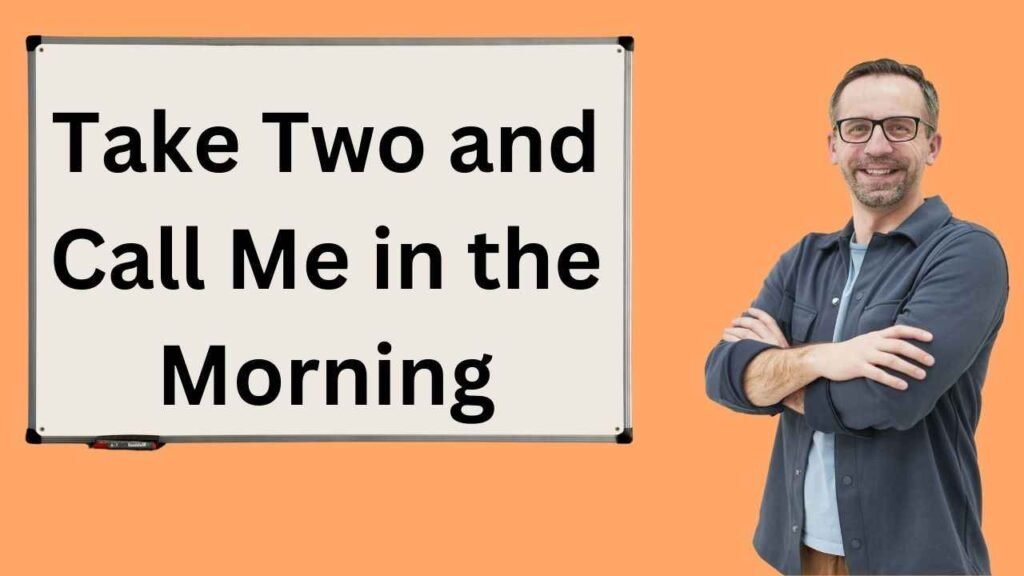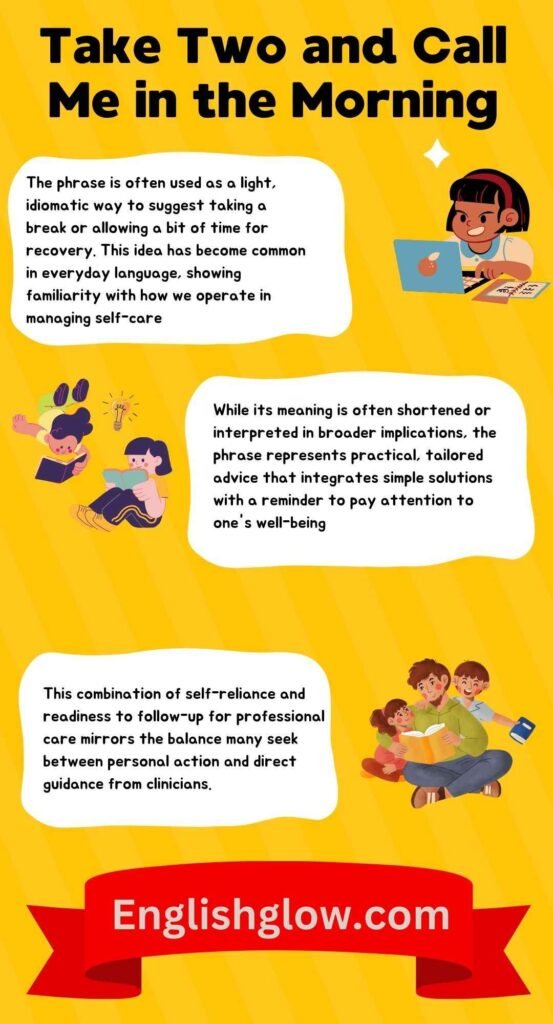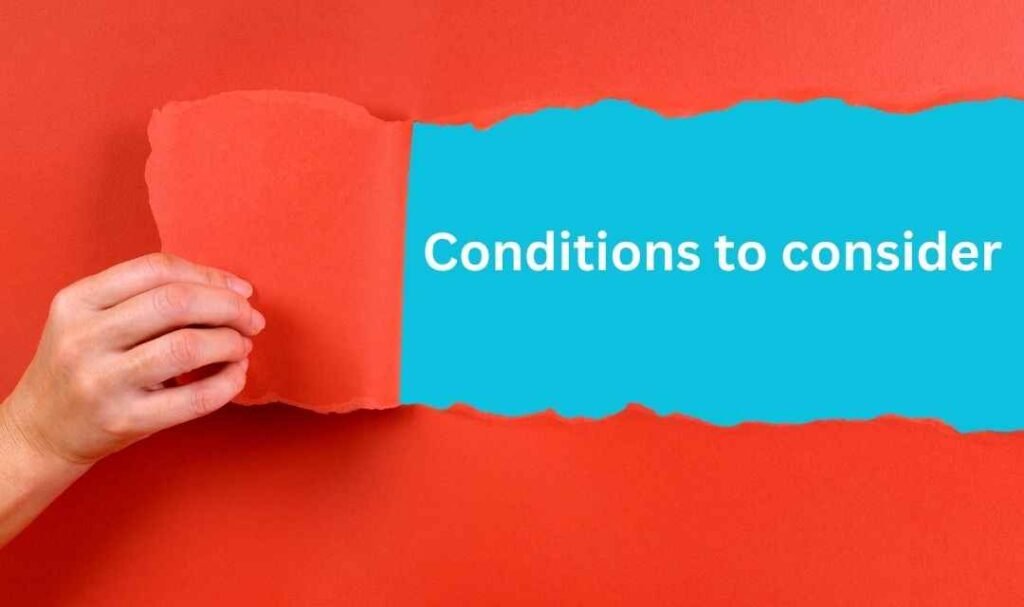The phrase “Take Two and Call Me in the Morning” holds a meaning that goes beyond its use as straightforward medical advice. This expression is deeply rooted in doctor-patient relationships and reflects a balance of self-reliance and seeking care. At its core, it encapsulates the idea of managing minor illness at home with basic remedies, such as aspirin, before considering an immediate visit to a doctor. The concept encourages a period of rest and monitoring while recognizing that if the problem persists, further intervention is needed from a health care provider.
The phrase is often used as a light, idiomatic way to suggest taking a break or allowing a bit of time for recovery. This idea has become common in everyday language, showing familiarity with how we operate in managing self-care. While its meaning is often shortened or interpreted in broader implications, the phrase represents practical, tailored advice that integrates simple solutions with a reminder to pay attention to one’s well-being. This combination of self-reliance and readiness to follow-up for professional care mirrors the balance many seek between personal action and direct guidance from clinicians.
Incorporating phrases into everyday language
Using familiar phrases in everyday speech can help us operate more effectively and connect with others. Take, for example, the classic statement “Take two and call me in the morning.” This phrase has become more than just a simple sentence about dealing with a headache; it integrates ideas of self-care and reassurance. When we say it casually, it indicates a preference for simple solutions and boosts self-esteem, showing that things will likely get better with a little time and rest. This type of application in language makes daily conversations feel more natural and seamlessly relatable, helping people understand that taking a pause initially doesn’t mean ignoring an issue but caring for oneself with the hope of improvement.
You might enjoy reading: I Hope You Had a Great Weekend
Different ways of conveying the same emotion
Language thrives on diversity and offers many different ways of expressing the same emotion. When someone says, “Take two and call me in the morning,” it’s more than just words about pills; it demonstrates how communication can shift with mood and context. This phrase promotes creative alternatives and shows how adopting varied expressions can expand our linguistic toolkit. Whether it’s used in a playful tone or a caring note, it helps convey the message clearly and keeps the conversation engaging. The idea of saying, “Ring me tomorrow,” or “Take a couple of these and rest,” reflects this versatility and change in wording that supports meaningful interaction. This clear adaptability helps build richer, more effective communication.
When and where to use the phrase
The phrase “Take Two and Call Me in the Morning” is perfect for situations involving mild health issues, like a headache, fever, or the common cold. It serves as a gentle reminder that many manageable illnesses don’t need immediate professional intervention but instead benefit from simple care and observation. This expression allows people to assess the severity of their symptoms before making a decision on whether to seek medical attention. Its flexibility helps it seamlessly integrate into conversations, providing reassurance while reminding someone to monitor their condition and act if needed.
Conditions to consider
The phrase “Take Two and Call Me in the Morning” is often used when talking about minor ailments like headaches, muscle aches, or other mild pains. It suggests that a simple remedy like taking a couple of pills might be sufficient for relief. This expression promotes clear and practical communication while reminding the person to let the doctor know if there’s no change by the next morning. It also demonstrates how language thrives in its versatility by adopting familiar phrases that convey a similar message across different situations. This saying expands linguistic use by providing alternatives to standard advice, making it easy to understand and respond to different moods and conditions.
The meaning behind “take two and call me in the morning”.
The phrase “Take Two and Call Me in the Morning” is used to suggest a simple approach to minor issues by taking two pills and waiting until the next morning to let the doctor know if there’s no change. This saying conveys a clear and practical message, emphasizing that not all problems need immediate action. It demonstrates how language thrives in its versatility, as it can be adapted for different contexts and moods. The expression also expands communication by offering alternatives that promote expressing care in a light-hearted way. It shows how adopting similar phrases gives people easy-to-understand and relatable advice, which enhances linguistic diversity and flexibility.
Original of “Take Two and Call Me in the Morning.”.
Understanding the roots of the expression “Take Two and Call Me in the Morning” helps explain its deeper meaning. The phrase dates back to a time when doctor-patient relationships were more personal and intimate. Clinicians would confidently prescribe a straightforward solution, often involving simple remedies, and then suggest a follow-up call if more care was needed. This approach showed that doctors knew their patients intimately and could make tailored advice that felt warm and supportive. It was a reminder that health care could be both practical and caring, providing an experience where treatment was made direct and patient-focused.
You might enjoy reading: Other Ways to Say Don’t threaten Me
Conclusion
The phrase “Take Two and Call Me in the Morning” is more than just a simple instruction; it’s an expression rooted in the historical context of personalized medicine. This timeless adage is often attributed to doctors who wanted to offer quick yet effective advice while encouraging patients to monitor their health overnight. The saying encapsulates the critical blend of self-reliance and the invaluable guidance of medical professionals. It highlights how the delicate balance between treating oneself and knowing when to seek professional help has been ingrained in our cultural lexicon for generations.
In today’s world, this phrase invites us to think about the evolving dynamics of healthcare and the increasing role of self-care in contemporary practices. As patients learn to navigate the complexities of modern medicine, this saying serves as a poignant reminder that while self-care is important, the expertise of medical professionals remains vital. This changing nature of the doctor-patient relationship shows how understanding and practice in healthcare have been shaped by a mix of traditional wisdom and modern approaches. It’s a mean to bridge past and present, illustrating how a simple phrase continues to resonate in our approach to health.





